#Papers of Georg and Max Bredig
Explore tagged Tumblr posts
Text
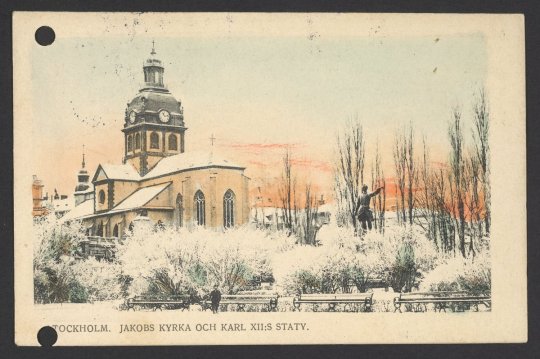
Oh, how I wish Philly was covered in snow like this postcard of Stockholm, Sweden.
It's been a while since we've seen a good old fashioned snow storm here in the city. Maybe I'll sleep with my pajamas on inside out tonight....
Image citation: Arrhenius, Svante. “Postcard from Svante Arrhenius to Georg Bredig, June 1911,” 1911. Papers of Georg and Max Bredig, Box 1, Folder 5. Science History Institute. Philadelphia.
#snow#i want snow#holidays#winter#snow in the city#philadelphia#philly#philly philly#postcards#bredig collection#archives#from the archives#special collections#digital collections#othmeralia
9 notes
·
View notes
Text

Why settle for being just a Baroness-Professor when you can be a Princess-Professor?
Think big, friends! Margarete von Wrangell (1877-1932) was an agricultural chemist and Germany's first female full professor. She married her childhood friend, Prince Vladimir Andronikov, in 1925. This marriage gave her the title of Princess Andronikov, which was a an addition to her title at birth, Baroness von Wrangell.
This article, in German, mentions that the marriage gave her Russian citizenship. Take a peek on our digital collections site.
#women in stem#women scientists#women professors#biology#princesses#princess#baronesses#baroness#chemistry#agricultural chemistry#german scientists#archives#papers of georg and max bredig#othmer library#othmeralia
81 notes
·
View notes
Text
Liegnitzer Bomben in the Archives!

Postcard from Svante Arrhenius to Georg Bredig, January 1896
In 1896 Svante Arrhenius thanked Georg Bredig for sending him Liengnitzer Bomben. Liegnitzer Bomben, also known as Legnica bombs or legnickie bomby, are small cakes made out of gingerbread and filled with fruit and marzipan. They were made to be Christmas treats or souvenirs of visitors from other cities.

Von SKopp - Eigenes Werk, CC BY-SA 3.0
The bombs were first made by the Müller brothers in 1853, but there is a fable associated with the recipe. According to legend, the recipe was presented to a baker by a mountain spirit in a dream. The baker had dreamed of making a famous dessert for Legnica. The mountain spirit, Rübezahl, gave the recipe to the baker. As the baker read the recipe gnomes appeared and started baking the bombs. When the baker woke up the kitchen was filled with freshly baked bombs and the recipe was written down, signed by Liczyrzepa, the mountain spirit.
The recipe has been a coveted secret after World War II and was patented so that it could not be shared. It is kept at the Copper Museum in Legnica and until recently it was not public.
Below is the original recipe translated from Polish
Liegnitzer Bomben (Legnica bombs)
Cake:
500 g flour
400 g honey
250 g sugar
200 g apricot jam
150 g butter
125 g chopped almonds
50 g chopped lemon jelly in frosting
50 g chopped orange jelly in frosting
125 g raisins
2 tablespoons cocoa
1 teaspoon gingerbread spices
4 ml rum
4 eggs
1 packet baking powder
margarine for greasing
breadcrumbs for sprinkling
For the topping:
200 g of chocolate
Preparation:
Melt honey, fine sugar and butter while stirring, then leave to cool. Eggs with cocoa, almonds, gingerbread spice and rum. Mix it with baking powder, flour and add the cooled honey mixture to it, mix.
Mix the washed, dried raisins with finely chopped marzipan, orange jelly, lemon jelly and jam. Instead of apricot jam, you can also use 100 g of small, baked, candied pineapples for the filling.
Grease 12 bomb molds and sprinkle with breadcrumbs. Half-fill the dough, put the marzipan mass on it and cover with the rest of the dough. Bake in an oven preheated to 350 degrees for about 30 minutes. Melt the chocolate glaze and spread on the Legnica bombs.
69 notes
·
View notes
Text
Scientist Spotlight in the Bredig Archives: Robert Koch, German Microbiologist, Physician, and Nobel Prize Winner
In February 1901, Georg Bredig, a physical chemist working in the laboratory of Wilhelm Ostwald in Leipzig, Germany, sent a copy of his habilitation thesis “Anorganische Fermente” (Inorganic Ferments) to the eminent German microbiologist and physician, Robert Koch (1843-1910), which Koch later thanked him for. A habilitation is the procedure to achieve the rank of professor in many European countries, including in the German speaking lands of Bredig’s time.
Together with Louis Pasteur, Robert Koch is regarded as one of the founders of modern microbiology, particularly for his discovery of various causes of infectious diseases such as cholera, tuberculosis, and anthrax. For his work on tuberculosis, Koch received the Nobel Prize for Physiology or Medicine in 1905. To learn more about Robert Koch, you can read his biography and view a photographic reproduction of his portrait in the digital collections of the Science History Institute.
#robert koch#nobel prize winners#microbiology#papers of georg and max bredig#georg bredig#habilitation thesis
6 notes
·
View notes
Text
The Nobel Institute and the Nobel Prize
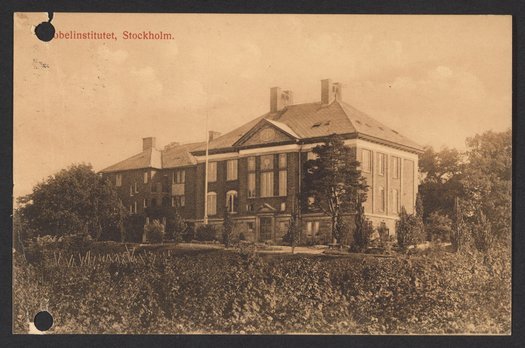
On January 2nd, 1896, Svante Arrhenius wrote a postcard to his dear friend Georg Bredig, telling him the latest news of the great Nobelian fortune. Arrhenius further says that this fortune, left by Alfred Bernhard Nobel, will be put in a fund to "be used to reward scientific work from around the world."
This fund became the Nobel prize, awarded for Physics, Chemistry, Physiology or Medicine, Literature and Peace. Below is an excerpt from Alfred Nobel’s will, which describes the Nobel prize and each of its categories.
“All of my remaining realisable assets are to be disbursed as follows: the capital, converted to safe securities by my executors, is to constitute a fund, the interest on which is to be distributed annually as prizes to those who, during the preceding year, have conferred the greatest benefit to humankind. The interest is to be divided into five equal parts and distributed as follows: one part to the person who made the most important discovery or invention in the field of physics; one part to the person who made the most important chemical discovery or improvement; one part to the person who made the most important discovery within the domain of physiology or medicine; one part to the person who, in the field of literature, produced the most outstanding work in an idealistic direction; and one part to the person who has done the most or best to advance fellowship among nations, the abolition or reduction of standing armies, and the establishment and promotion of peace congresses. The prizes for physics and chemistry are to be awarded by the Swedish Academy of Sciences; that for physiological or medical achievements by the Karolinska Institute in Stockholm; that for literature by the Academy in Stockholm; and that for champions of peace by a committee of five persons to be selected by the Norwegian Storting.”
The first Nobel Prize would not be awarded until 1901. In 1903 Arrhenius would be the third person to be awarded the Nobel Prize in Chemistry for his electrolytic theory of dissociation.
In March 1905, Arrhenius wrote to Bredig that the Nobel Institute for Physics and Chemistry would open on October 1st, 1905. While the Nobel Institute opened in October 1905, the actual building wouldn't open its doors until May 1906. Because of this, the Nobel Institute of Physics and Chemistry met at Svante Arrhenius’s home.
In this letter, he writes about his hopes and goals for physical building. He says that the building has three floors, the first will be the institute, the second will be meeting rooms for the committee members, and the third will be for assistants and servants.

In Letter from Svante Arrhenius to Georg Bredig, February 1905 , Arrhenius tells Bredig of the modest conditions that Meyerhoffen and Jacobus Henricus van 't Hoff (1852 – 1911) work in. he provides measurements of the rooms and even comments on the poor lighting. He uses this as an example of what he does not want at his new institution and says that his laboratory will be “significantly better.”
Arrhenius continues to write to Georg Bredig about the institute through his life. Check out the digital collections for more Arrhenius letters in the archive!
#othmeralia#Svante Arrhenius#Georg Bredig#Nobel Institute#nobel prize#German Chemists#Swedish Chemists#fragments#notebooks#antique#Papers of Georg and Max Bredig
15 notes
·
View notes
Text

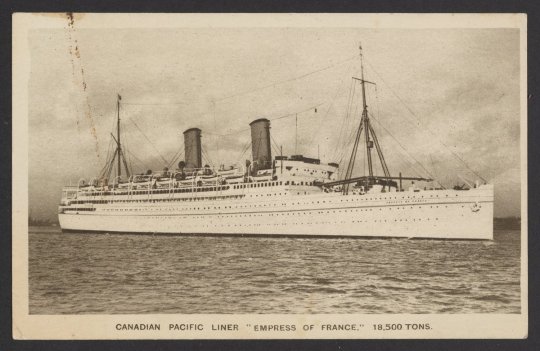
A fun game the archivists at the Science History Institute get to play sometimes is "Match the scientist to the signature!". So far in this postcard we have identified.
Mario Betti, 1875-1942
Paul Peter Ewald , 1888-1985
Robert Robertson,
John Richardson Marrack , 1886-1976
James Riddick Partington, 1886-1965
F. G. (Frederick George) Donnan , 1870-1956
Lucas, R
Let us know if you can identify anyone! This postcard, addressed to Georg Bredig, is part of the Papers of Georg and Max Bredig. It was signed by attendees of a scientific conference in London, 1930.
9 notes
·
View notes
Text

As we're working through cataloging much of our Max and Georg Bredig Collection we find gems like this!
This book is Kleine fabel für meine geige (1933). It has not been cataloged yet but will be soon! Check back for updates.
The archive bib record is found here, which has links to the finding aid and the EAD version. You can also head to our digital collections site to see everything we've digitized in this collection so far! Spanning the years 1891 to 1947, this collection consists of photographs, correspondence, and manuscript materials chronicling the life and career of prominent German-Jewish physical chemist Georg Bredig (1868-1944) and, to a lesser extent, his son Max.
#papers of george and max bredig#scientists#beautiful books#german books#german scientists#history of science#othmer library#othmeralia
25 notes
·
View notes
Text
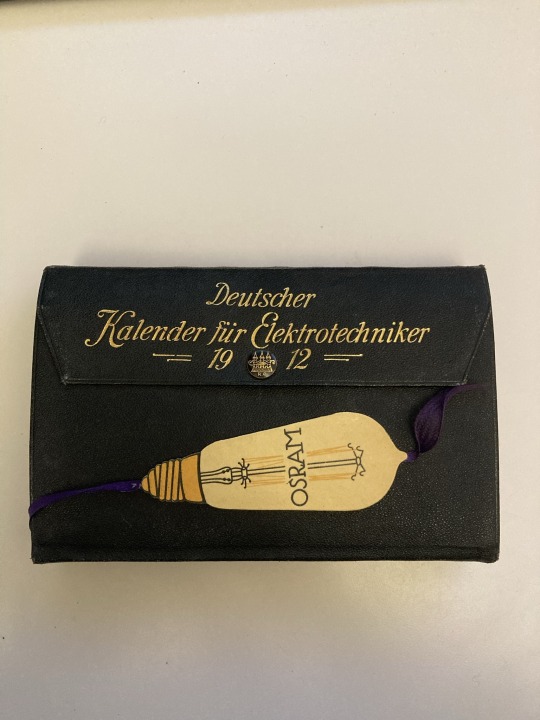

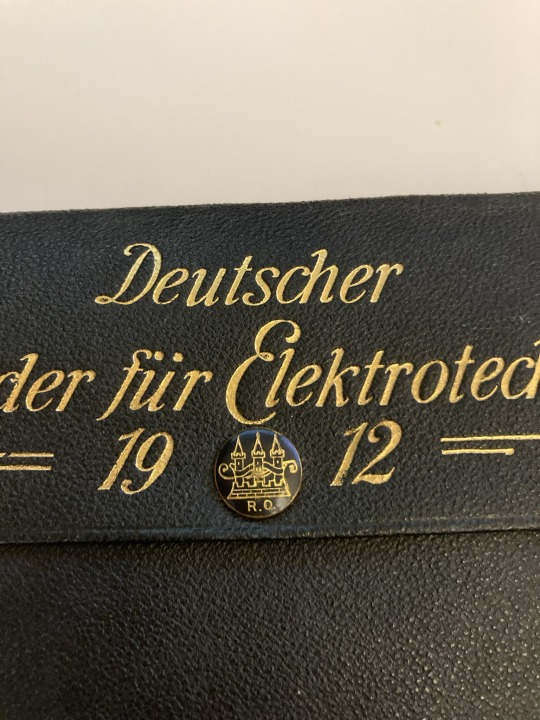
I wish all books would come bound like tiny briefcases from now on.
The Othmer Library recently acquired the archival collection of Georg and Max Bredig, father and son German-Jewish chemists who immigrated to the United States as World War II was threatening their livelihood in Germany.
The archival collection included tons and tons of books and journals that have made their way into our modern collection, and we are just chuffed about it! Pictured above is Deutscher Kalender für Elektrotechniker. We are still in the process of cataloging this donation and will update this post later on with a link to it's record!
#journals#papers of george and max bredig#max bredig#Georg bredig#german books#German scientists#german jewish scientists#journal collection#othmeralia
15 notes
·
View notes
Text
Christmas in the Papers of Max and Georg Bredig!
Merry Christmas from the team working on the Papers of Max and Georg Bredig!
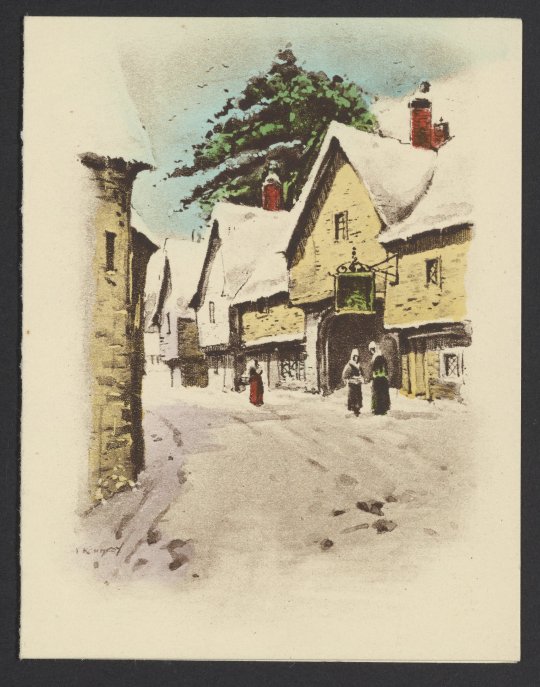
Christmas card from Ilse Wolfsberg to Max Bredig, December 11, 1942. At this time Max Bredig and Ilse Wolfberg were fighting for the release of their friend Fritz Hochwald from a concentration camp in Spain. They never took a break from their mission, even during the holiday season.
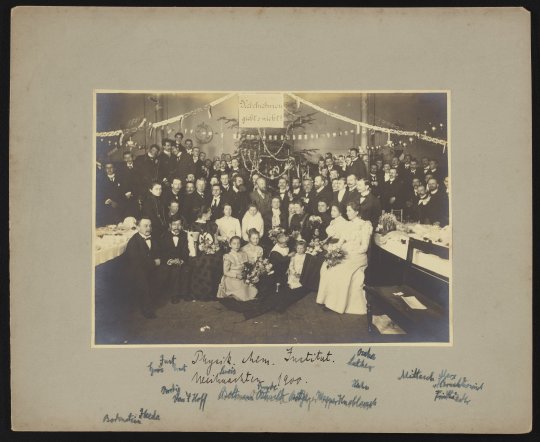
University of Leipzig physical chemistry department Christmas party, 1900. This photograph features a large group at a Christmas party. The room is decorated is for Christmas with banquet tables set for a meal.
10 notes
·
View notes
Text
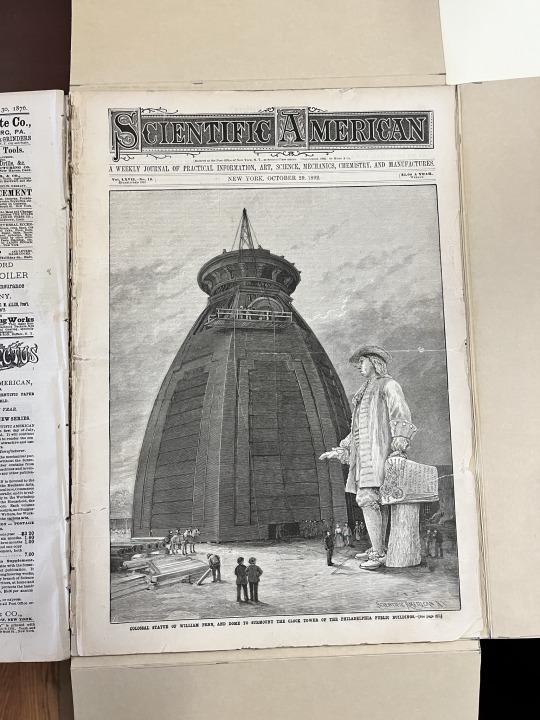
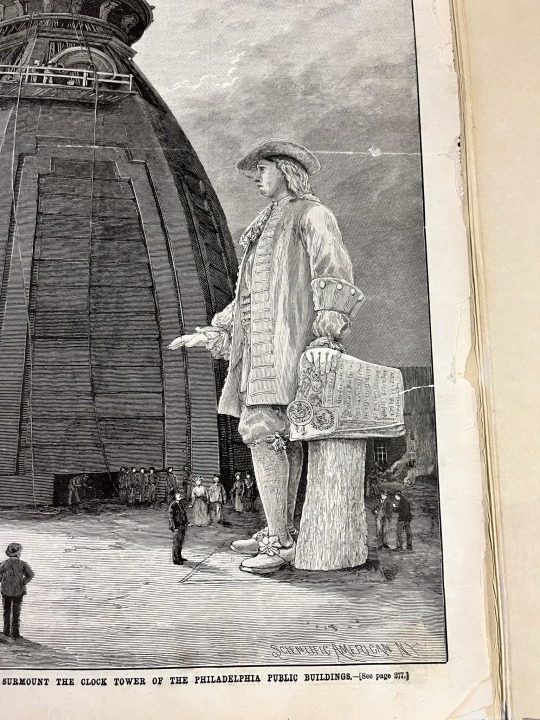
The Curse of Billy Penn
Did any of our followers know that there is a statue of William Penn on top of Philadelphia's City Hall?
We recently picked up a few new (to us) copies of Scientific American, a science and technology journal, from a local library (shout out to The Union League!). One issue features the statue of William Penn, founder of Pennsylvania (though it is important to note that Philadelphia specifically is the ancestral home of the Lenni Lenape or Lennapehoking people), before it was placed on top of Philadelphia City Hall.
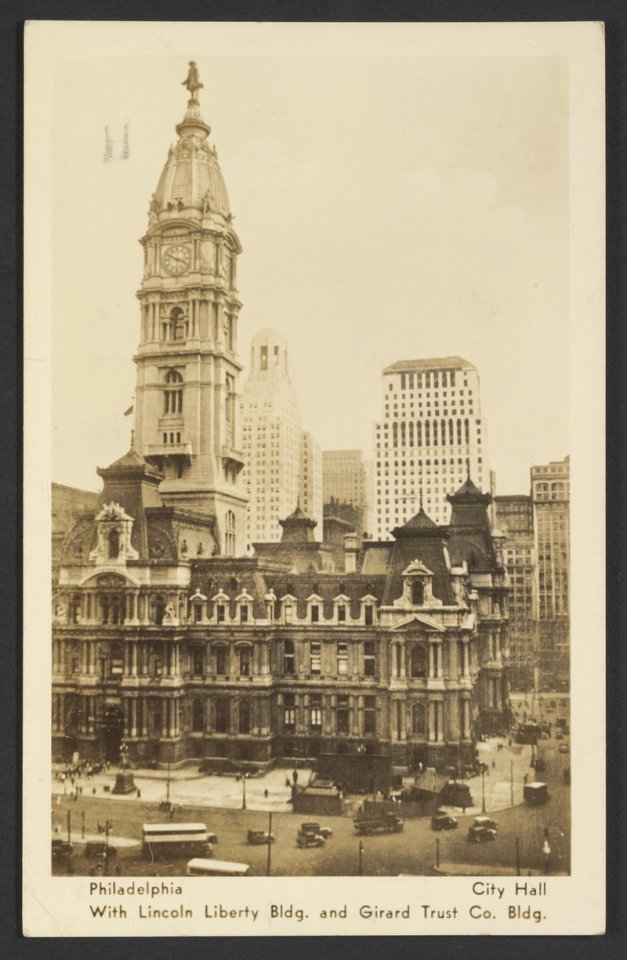
William Penn was the product of Alexander Milne Calder, a Scottish-American sculptor, and is 37 feet tall.
For almost 90 years there was an unwritten agreement or understanding that forbade any building in the city from rising above William Penn. This agreement ended when Liberty Place was approved and built in 1987 causing the Curse of Billy Penn to cause disaster on all Philadelphia sports-teams. Pre-1987 Philadelphia sports teams enjoyed a run of success. Post-1987, the curse held on to the city so tightly until the Philadelphia Phillies won the World Series in 2008.
How did the curse end? Well it did and then didn't. The Comcast Center was built in 2007 and a few iron workers decided to place a tiny statue (about 4 inches tall) on top to make William Penn, yet again, the tallest figure in the city. The Philadelphia Phillies won the World Series in 2008, breaking the curse.
Then! In 2017, a new building became the tallest building in Philly. A second Comcast Center. Once again, iron workers placed a tiny Billy Penn on top... the Philadelphia Eagle went on to absolutely crush the New England Patriots in the 2018 Super Bowl. Go birds!

Photo credit: Höber, R. “Postcard from R. Höber to Georg Bredig,” April 23, 1935. Papers of Georg and Max Bredig, Box 1, Folder 59. Science History Institute.
#philadelphia#philadelphia history#philadelphia eagles#william penn#curse of billy penn#scientific american#sculpture#history#science history#local history#go birds#eagles#digital collections#libraries#libraries of tumblr#special collections#journal collection#alexander milne calder#othmer library#scientific illustration#othmeralia
24 notes
·
View notes
Text

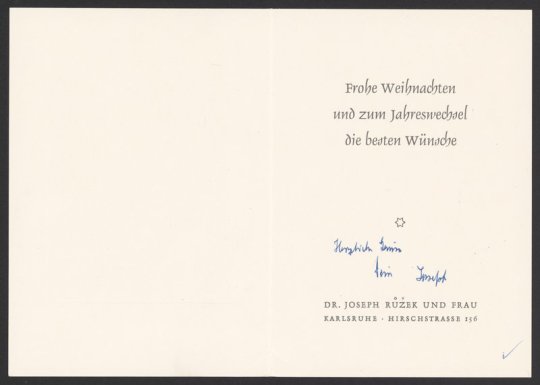
Holiday card from Mr. and Mrs. Joseph Ruzek to Georg Bredig
A Christmas card featuring a black and white illustration of a winter nighttime scene. The view shows a snow-covered Karlsruher Schloss, or Karlsruhe palace.
Here's a transcription of the German written on the back of the postcard:
Frohe Weihnachten und zum Jahreswechsel die besten Wünsche
Herzliche Grüsse Dein Joseph
Dr. Jospeh Ruzek und Frau KARLSRUHE – HIRSCHSTRASSE 156
Here is the English translation:
Merry Christmas and Best Wishes for the New Year!
Warm Regards Joseph
Dr. and Mrs. Jospeh Ruzek KARLSRUHE – HIRSCHSTRASSE 156
Image citation: Ruzek, Joseph. “Holiday Card from Mr. and Mrs. Joseph Ruzek to Georg Bredig,” n.d. Papers of Georg and Max Bredig, Box 2, Folder 47. Science History Institute. Philadelphia.
#christmas#german#scientists#german scientists#ephemera#illustrations#Karlsruhe#Bredig Papers#Archival collections#archives#image archives#othmeralia
11 notes
·
View notes
Text
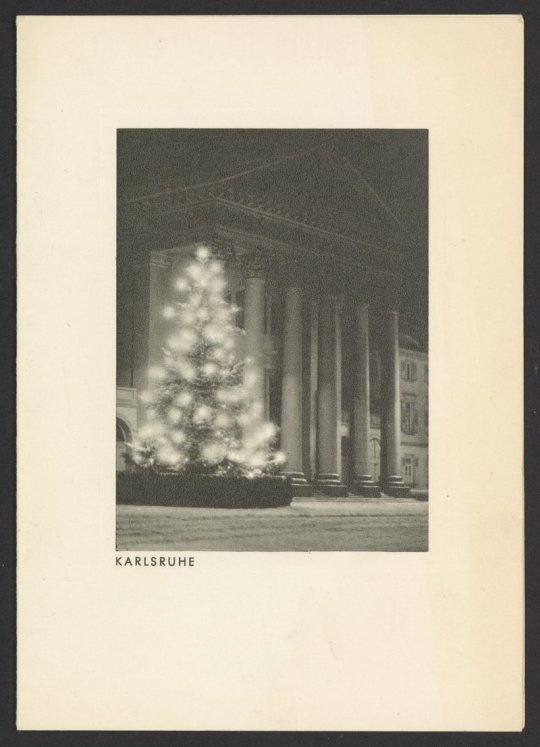
O Christmas Tree, O Christmas Tree!
A Christmas card featuring a black and white illustration of a large adorned Christmas tree at the Rondellplatz, or the city square of Karlsruhe, Germany.
Image citation: Ruzek, Joseph. “Christmas Card from Mr. and Mrs. Joseph Ruzek to Georg Bredig,” n.d. Papers of Georg and Max Bredig, Box 2, Folder 47. Science History Institute. Philadelphia.
#christmas#christmas tree#bredig papers#georg bredig#archival collection#archives#image archives#photo archives#tannenbaum#holidays#happy holidays#german scientists#othmeralia
10 notes
·
View notes
Text
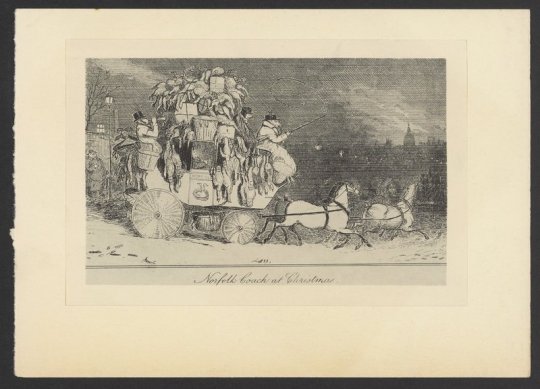
Norfolk Coach at Christmas
Reproduction of a print by artist Robert Seymour (1798-1836) originally completed circa 1820. The Norfolk Coach depicts a horse-drawn carriage being pulled through snowy streets and piled high with pheasants.
Image citation: Seymour, Robert. “Norfolk Coach at Christmas.” New York, New York: New York Public Library, n.d. Papers of Georg and Max Bredig, Box 10, Folder 7. Science History Institute. Philadelphia.
#christmas#science history institute#bredig archives#photo archives#archival collections#archives#max and georg bredig#bredig#othmeralia
17 notes
·
View notes
Text
The Andrée's Arctic Balloon
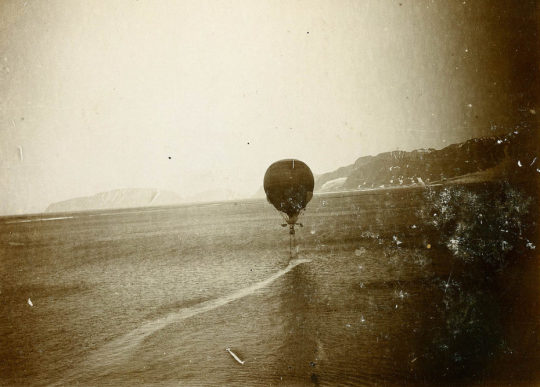
Photo: Perspektivet Museum
In 1897, a group of Swedish explorers went to the North Pole in an air balloon and disappeared. Their fate would not be known for 30 more years. Tendrils of this story can be found in the letters between Svante Arrhenius and Georg Bredig.
The Andrée's Arctic balloon expedition took place in 1897 in which S. A. Andrée, Knut Frænkel, and Nils Strindberg voyaged by hydrogen balloon from Svalbard in July 1897, the plan was to fly over the north pole, as a way to advance Sweden's place in the race to the north pole.
Svante Arrhenius tells Georg Bredig about his friend Strindberg’s impending expedition in a letter written only months before the expedition.
“Strindberg is supposed to leave his bride and travel with Andrée to the North Pole with the 4th version of the Perpetuum mobile (they leave on May 17th).” - Letter from Svante Arrhenius to Georg Bredig, May 1899
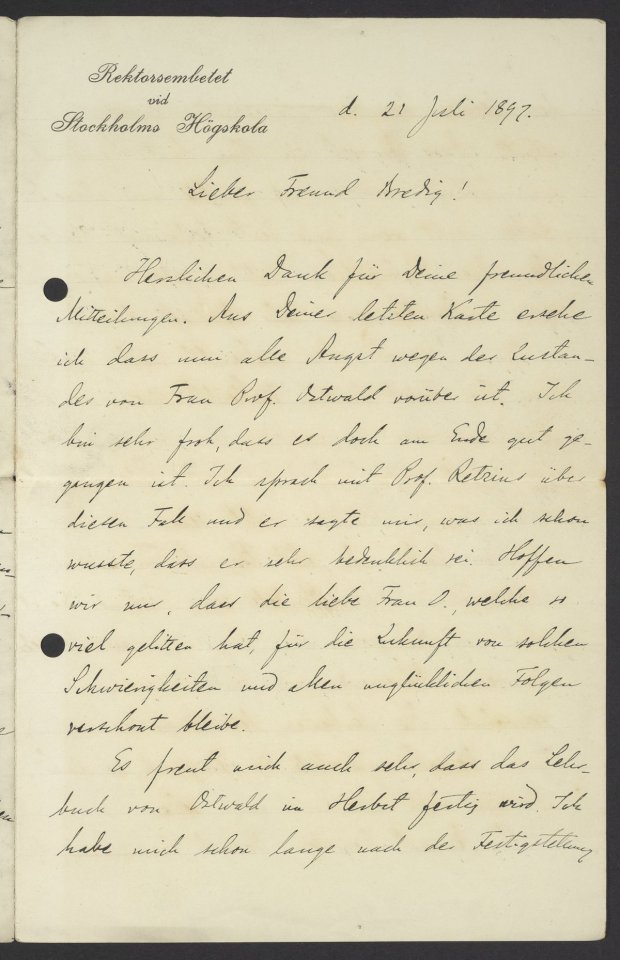
On July 21, 1897, Arrhenius wrote
“One topic of lively discussion here is the polar expedition and how its three explorers are faring. The trip may take a month or maybe even longer. Perhaps they are sitting in snowdrifts and cannot travel further. Such a situation must be unpleasant.”
Letter from Svante Arrhenius to Georg Bredig
Andree was Sweden's first balloonist and proposed the expedition. Fraenkel was a Swedish engineer and Strindberg was a Swedish scientist and photographer. Unfortunately, the expedition was not completed and all three expedition members perished.
The balloon quickly lost hydrogen within the first two days of the expedition and crashed into a pack of ice, leaving the explorers in Svalbard. In October 1897 the three men made it to Kvitøya (White Island) in Svalbard. The island is almost completely covered in an ice cap and uninhabited. The three men were not able to survive the harsh arctic weather and perished.
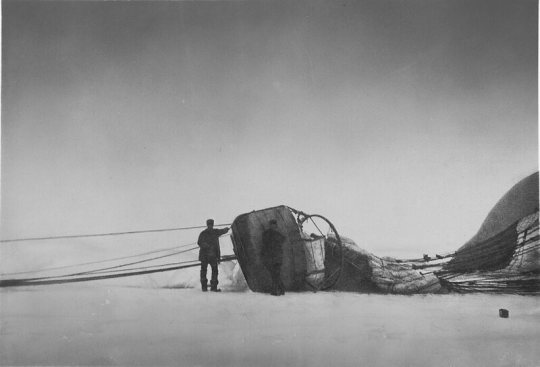
Posing with the wreck (via Tekniska museet)
No one knew the fate of the explorers until August 5, 1930, when, due to a particularly warm summer, sealers could access the island. There they found the remains of the three men, their boat, journals, and exposed rolls of film that Stringbeg had taken. 93 photographs were able to be developed.
The photographs capture the balloon’s crash and the months following. The photographs show the camps they set up, hunting polar bears, and other realities of living in the arctic.
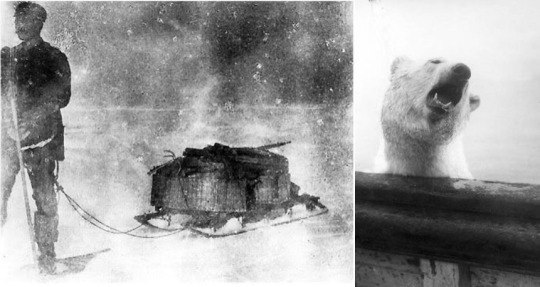
Photo: Neil Strindberg
To see more photos that have been developed visit
To learn more about the Papers of Max and Georg Bredig visit the Technical Museums Flickr
#photography#history#archives#exploration#arctic exploration#S. A. Andrée#Nils Strindberg#Knut Fraenkel#svalbard#Nils Gustaf Ekholm#othmeralia
90 notes
·
View notes
Text
April 12: On this Day in History in the Bredig Archives, Svante Arrhenius writes about Cosmic Physics
The winner of the 1903 Nobel Prize for Chemistry and a founding member of the Nobel Institute, Svante Arrhenius (1859-1927) was a multifaceted Swedish scientist whose research endeavors included physical chemistry, cosmic physics, and immunologic chemistry.

Arrhenius’ work in the new field of physical chemistry in the late 19th and early 20th centuries comprised the early years of his career. As a doctoral and postdoctoral student in his native Sweden, and at laboratories in Latvia and Germany, he worked on electrolytes and in 1889, developed the Arrhenius equation, a mathematical expression describing the effect of temperature on the velocity of a chemical reaction. Around this same time while working at Wilhelm Ostwald’s laboratory at the University of Leipzig, Arrhenius also became acquainted with Georg Bredig, who would become an eminent physical chemist in his own right. Over the next four decades, the men corresponded about their lives, scientific endeavors, developments, and achievements, as well as world affairs.
Several of Arrhenius’ letters to Bredig provide keen insight and detail into his later work outside of physical chemistry. In a letter dated April 12, 1914, for example, Arrhenius tells Bredig of his recent trip to Norway to speak about his interest in “cosmogony”:
“Thank you for your kind letter from March 26th. On this day, I returned from a three-week trip in Norway, where I lectured on Cosmogony in Trondheim and Bergen. The reception committees were very welcoming, and the audiences were extremely interested….It is very encouraging to witness the keen interest of the audience.”
Cosmogony, which is derived from the Greek words “kosmos” and “genesis”, refers to theories or myths concerning the creation of the universe. Arrhenius attention to the subject most likely resulted from his work in cosmic physics and the concept of “panspermia”, the notion that life evolved on earth from spaceborne spores. Arrhenius would later write two popular books on the subject: Worlds in the Making (1908) and The Destinies of the Stars (1918). To read more about the life and work of Svante Arrhenius, as well as his letters to Georg Bredig, visit the Papers of Georg and Max Bredig in the Digital Collections of the Science History Institute.
By: Jocelyn McDaniel, Research Curator of the Bredig Archive
#othmer library#arrhenius#bredig papers#physics#astronomy#cosmos#galaxies#solar system#cosmic physics#georg bredig
28 notes
·
View notes
Text


Christmas card from Ilse Wolfsberg to Max Bredig.
Head on over to our digital collection site to read the German transcription and the English translation of this seasonal card.
Image citation: Wolfsberg, Ilse. “Christmas Card from Ilse Wolfsberg to Max Bredig, December 11, 1942,” December 11, 1942. Papers of Georg and Max Bredig, Box 9, Folder 25. Science History Institute. Philadelphia.
#christmas#christmas cards#german scientists#bredig papers#max bredig#archives#archival collections#image archives#photo archives#German#holidays#digital collections#othmeralia
5 notes
·
View notes